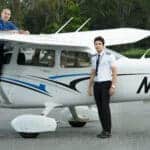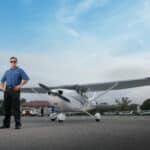Spatial Disorientation in Flight: Causes, Effects, and How to Prevent It

Spatial disorientation in flight is one of the most dangerous conditions a pilot can face. It happens when your senses mislead you about the aircraft’s position, motion, or attitude—often with deadly consequences. In IMC (Instrument Meteorological Conditions) or low visibility, even experienced pilots can become disoriented, misjudge their orientation, and lose control of the aircraft.
According to FAA data, spatial disorientation is a contributing factor in a significant number of general aviation fatalities. It doesn’t just affect beginners. It strikes quickly, often without warning, and typically ends in controlled flight into terrain or unrecoverable stall/spin scenarios.
This guide explains how spatial disorientation happens, what illusions pilots need to recognize, and—most importantly—how to prevent it through training, awareness, and sound flight discipline.
What Is Spatial Disorientation in Flight?
Spatial disorientation in flight occurs when a pilot’s sensory systems—vision, inner ear, and kinesthetic perception—send conflicting signals about the aircraft’s position and motion. In simple terms, it means the brain can’t accurately interpret whether the aircraft is climbing, turning, or flying level.
Under normal conditions, pilots rely heavily on visual cues outside the cockpit to maintain orientation. But in low visibility or at night, those external references disappear. Without them, spatial disorientation in flight becomes a real threat—especially when relying on physical sensations alone.
The human vestibular system, located in the inner ear, helps detect movement and balance. However, it’s prone to error in flight, especially during prolonged turns or sudden accelerations. That’s why spatial disorientation in flight can occur even when everything feels “normal” to the pilot—leading to unrecognized turns, spiral dives, or steep descents.
Understanding the science behind spatial disorientation in flight is the first step toward avoiding it. Trusting your instruments over your instincts becomes critical when your senses start to fail.

Common Scenarios That Trigger Disorientation
Spatial disorientation in flight doesn’t need extreme weather or mechanical failure to occur. In fact, it often strikes during routine conditions—especially when visibility is limited or when a pilot transitions from visual to instrument flight.
Flying at night over featureless terrain, like open water or dark countryside, can disorient the brain quickly. Without a visual horizon, the risk of spatial disorientation in flight increases dramatically. The same applies when flying through clouds or haze, where external references vanish and illusions take over.
Another common trigger is sudden entry into IMC without being instrument-rated or current. In such cases, spatial disorientation in flight can develop within seconds, leading to dangerous control inputs and loss of aircraft orientation.
Even rapid acceleration or deceleration can confuse the inner ear and contribute to spatial disorientation in flight. The body may perceive a climb during takeoff or a descent during a level turn—pushing the pilot to make incorrect corrections.
Being aware of these high-risk scenarios is essential. Avoiding unnecessary maneuvers, staying current on instrument procedures, and recognizing when you’re vulnerable can significantly reduce your chances of falling victim to spatial disorientation in flight.
Types of Spatial Disorientation Illusions
To fully understand spatial disorientation in flight, you need to know the specific illusions that affect a pilot’s perception. These illusions can create a false sense of motion or orientation, leading to dangerous control inputs and loss of aircraft control.
The Leans: This illusion happens when a slow bank is entered too gradually to trigger the vestibular system. When the aircraft is leveled, it feels like it’s banking in the opposite direction. It’s one of the most common forms of spatial disorientation in flight.
Coriolis Illusion: Caused by moving the head during a prolonged turn, this illusion makes the pilot feel a tumbling or spinning sensation. In the context of spatial disorientation in flight, it’s particularly disorienting because it combines conflicting visual and inner ear inputs.
Graveyard Spiral: After flying in a prolonged turn, the pilot may feel straight and level even when the aircraft is in a descent. Attempting to level out can tighten the spiral. This is one of the deadliest outcomes of spatial disorientation in flight.
Somatogravic Illusion: Rapid acceleration during takeoff can make the pilot feel like the nose is too high, leading to a dangerous pitch-down response. This illusion often contributes to spatial disorientation in flight when taking off into low visibility.
Inversion Illusion: Occurs during a sudden transition from climb to straight-and-level flight. The pilot may feel like the aircraft is tumbling backward, prompting a nose-down input that can lead to a dive—another classic trap of spatial disorientation in flight.
Recognizing these illusions—and knowing they can trick even seasoned pilots—is key to staying in control when faced with spatial disorientation in flight.

How Pilots React Under Disorientation
When experiencing spatial disorientation in flight, many pilots instinctively trust their body over their instruments—a critical mistake. The inner ear can give powerful but misleading sensations that feel convincing, especially when visual references are gone.
In most cases of spatial disorientation in flight, pilots believe they are flying straight and level when they’re actually in a turn or descent. Attempts to “correct” what feels wrong can result in worsened attitudes, increased bank angles, or abrupt altitude loss. This is often how controlled flight into terrain (CFIT) begins.
One example includes pilots entering IMC during a climb, only to pitch the nose down because of a false sensation of excessive nose-up attitude. In several fatal incidents, cockpit voice recordings and NTSB data reveal that even trained aviators struggled to override their instincts when affected by spatial disorientation in flight.
Proper reaction starts with recognizing that spatial disorientation in flight is happening. Pilots are taught to “believe your instruments”—but in practice, that’s easier said than done. The key is disciplined instrument scanning, resisting sudden control inputs, and maintaining a calm, procedure-driven response.
How to Prevent Spatial Disorientation in Flight
Preventing spatial disorientation in flight starts with understanding when and how it occurs. Pilots must recognize the early signs, trust their instruments over their senses, and avoid the risky behaviors that lead to disorientation in the first place.
The most effective defense against spatial disorientation in flight is consistent instrument training. Pilots who fly in marginal VFR or IMC conditions should stay proficient in instrument flight rules (IFR). Regular practice helps reinforce trust in cockpit displays, especially when the body sends conflicting messages.
Another important preventive measure is proper preflight planning. If there’s any chance of entering low-visibility conditions, avoid the flight or prepare with the right charts, alternates, and weather updates. Many cases of spatial disorientation in flight could have been avoided with better go/no-go decisions.
Physical condition also plays a role. Fatigue, dehydration, or illness can impair reaction time and judgment, making spatial disorientation in flight more likely. Ensuring you’re physically and mentally ready before flying is just as important as checking the aircraft.
Finally, avoid abrupt control movements, especially in reduced visibility. Smooth, deliberate inputs combined with a steady scan of the attitude indicator and other key instruments can help prevent spatial disorientation in flight before it begins.
Training Techniques to Improve Situational Awareness
Effective training is the foundation for preventing spatial disorientation in flight. While no pilot is immune to sensory illusions, targeted training can sharpen awareness, reinforce trust in instruments, and improve decision-making under pressure.
Flight simulators are especially valuable. They allow pilots to experience spatial disorientation in flight in a controlled environment, where instructors can introduce scenarios like sudden IMC entry, gradual turns, or instrument failures. These exercises teach pilots how it feels to be disoriented—and how to correct safely.
Another proven method involves practicing unusual attitude recovery. During these exercises, instructors simulate loss of orientation, forcing the pilot to regain control using instruments alone. This builds confidence and reinforces muscle memory—both crucial in real-life cases of spatial disorientation in flight.
Military and airline training programs often emphasize spatial orientation awareness early in pilot development. This includes lessons on how the vestibular system works, how illusions occur, and how to respond without hesitation. Private pilots, too, benefit from adding similar modules into their proficiency training.
In every case, repetition matters. Ongoing training helps ensure that if spatial disorientation in flight does occur, the pilot knows exactly how to respond—with discipline, clarity, and control.
What to Do If You Experience Disorientation Mid-Flight
Recognizing and responding quickly to spatial disorientation in flight can mean the difference between recovery and disaster. The first and most important rule is: trust your instruments, not your senses. When disorientation sets in, your body will lie to you—but your instruments won’t.
If you suspect spatial disorientation in flight, immediately shift your attention to the attitude indicator, heading indicator, and airspeed. Avoid abrupt control inputs and maintain level flight using a steady instrument scan. Resist the urge to “correct” based on how the aircraft feels.
Power management is also key. Apply cruise or climb power as needed, depending on your phase of flight. Avoid trimming for feel—trim based on what your instruments indicate. Pilots who experience spatial disorientation in flight often make the mistake of trimming for a false sensation of pitch or bank, worsening the situation.
When workload becomes too high or orientation is uncertain, communicate with ATC. Declare an emergency if needed. Controllers can provide headings, altitudes, and guidance that help you stabilize the flight. Don’t hesitate—many successful recoveries from spatial disorientation in flight involved early contact with controllers.
Above all, stay calm. Panic and overcorrection are deadly when battling spatial disorientation in flight. Trust your training, focus on the instruments, and follow your emergency procedures step by step.
Consequences of Spatial Disorientation
The consequences of spatial disorientation in flight are often severe—and in many cases, fatal. According to FAA accident data, a large percentage of fatal general aviation accidents involve disorientation, especially during night flights or in IMC conditions.
Pilots who lose control due to spatial disorientation in flight typically enter graveyard spirals, unrecoverable dives, or stall/spin scenarios. These events unfold quickly, and there’s often little time to react if the pilot isn’t immediately relying on their instruments. Many crashes occur within minutes of entering disorienting conditions.
The tragedy is that most of these accidents are preventable. Proper instrument proficiency, good aeronautical decision-making, and situational awareness could have broken the chain of events leading to disaster. This is why spatial disorientation in flight is such a high-priority topic in both civil and military pilot training.
Beyond the loss of life, these incidents also have regulatory and financial consequences. Investigations, license actions, and increased insurance risks follow any accident linked to spatial disorientation in flight. For flight schools and commercial operators, a single disorientation-related accident can jeopardize reputation and business continuity.
The key takeaway is clear: spatial disorientation in flight is not just a theoretical risk. It’s a real, measurable hazard that demands constant attention, ongoing training, and total respect from every pilot in the sky.
Conclusion
Spatial disorientation in flight remains one of the most dangerous threats in aviation—not because it’s rare, but because it’s subtle, fast, and unforgiving. No matter how experienced a pilot may be, the human body is not built for flying through low visibility without reference to instruments.
But the risk is manageable. Through proper training, situational awareness, and trust in your instruments, you can avoid the most common traps that lead to spatial disorientation in flight. Whether you’re flying VFR on a hazy evening or operating under IFR in IMC, knowing how to detect and respond to disorientation is part of what makes you a safe, professional aviator.
Mastery in aviation isn’t just about flying when the skies are clear. It’s about staying in control when your senses fail. And when it comes to spatial disorientation in flight, control starts with preparation.
Contact the Florida Flyers Flight Academy Team today at 91 (0) 1171 816622 to learn more about the Private Pilot Ground School Course.



